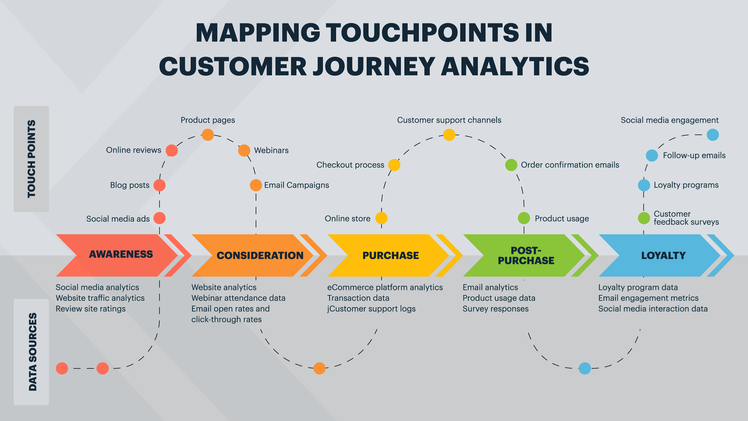In 2024, crafting a winning customer experience (CX) strategy is more crucial than ever. It’s the secret sauce that turns ordinary interactions into unforgettable experiences and drives measurable business results.
Why is a solid CX strategy so pivotal? The truth is, businesses that don’t prioritize CX are getting left behind. We live in an age where customer expectations are sky-high, and AI is transforming the landscape.
According to a Forrester study, companies prioritizing customer experience outperform their peers by as much as 80% in revenue growth. There is an undeniable link between an exceptional CX strategy and tangible business results. The gap between organizations that prioritize CX as a competitive differentiator will only grow, as AI continues to expand what’s possible for personalization.
This article outlines how to build a winning CX strategy. From understanding what a successful customer experience strategy truly is, and how to create one —let’s give you the tools to elevate your CX game.
Table of Contents
What is a Customer Experience Strategy?
How is Customer Experience Different from Customer Service?
What’s Included in a Customer Experience Strategy?
Customer Feedback and Insights
How to Create a Customer Experience Strategy
Define Your Customer Experience Vision
Understand Your Customer’s Journey
Gather and Analyze Customer Feedback
Implement Personalization Tactics
Monitor and Measure Performance
Continuously Improve and Innovate
What is a Customer Experience Strategy?
A customer experience strategy is your roadmap to delivering consistent, high-quality interactions with your customers. It ensures that every touchpoint is thoughtfully designed to meet and exceed customer expectations, paving the way for lasting relationships and business growth.
In a CX strategy, you map out the entire customer journey—from the initial marketing campaigns to the purchasing process, and even post-purchase support. You anticipate customer needs, address potential pain points, and ensure a smooth, engaging experience.
Why is it so crucial? Without a clear CX strategy, you can only react to customer issues as they arise, rather than proactively addressing their needs and expectations. As the waves of customer expectations continue to shift, without a solid map and compass, you’ll be lost in your ability to give customers what they want.
How is Customer Experience Different from Customer Service?
The term customer experience is often used interchangeably with customer service, but they’re actually two distinct concepts. Each has its own role in the customer journey.
Think of CX as the entire journey your customer takes with your brand. It’s the cumulative result of every interaction – from the first touchpoint through to post-purchase. CX encompasses the emotional and functional aspects of the customer’s journey and reflects how they feel about your brand based on their overall experience.
Customer service is a crucial component of CX, but it’s more focused. It deals with specific interactions, typically when customers reach out for support or assistance. It’s reactive and usually occurs when there’s an issue or inquiry. Good customer service resolves problems effectively, while poor customer service can negatively impact the overall CX. The customer support team plays a vital role in delivering good customer service by being well-trained and responsive to customer needs.
Why the difference matters
Understanding the difference helps you allocate resources and strategies effectively. A robust CX strategy integrates exceptional customer service into the broader customer journey. While great customer service can enhance the overall CX, a strategic approach to CX ensures that every interaction, not just the service ones, contributes to a positive and memorable customer experience.
What’s Included in a Customer Experience Strategy?
Creating a successful Customer Experience (CX) strategy isn’t about checking off a list—it’s about weaving together various elements to craft a seamless and engaging journey for your customers. One key metric for evaluating customer experience is the customer effort score (CES), which, alongside Net Promoter Score (NPS) and Customer Satisfaction Score (CSAT), provides actionable insights for improvement.
Here are five key elements you’ll want to include for a winning CX strategy.
Customer Journey Map
A customer journey map is a visual representation of the customer’s experience with your brand, from initial contact to post-purchase interactions.
This can look like mapping out a customer’s path from discovering your product via social media, through purchasing on your website, and finally receiving post-purchase support. The map helps you see where customers might encounter obstacles, and where you can enhance their experience.
Why It’s Important: It helps you understand every touchpoint and interaction customers have with your business. By identifying these moments, you can spot pain points and opportunities for improvement.

Customer Feedback and Insights
Collecting and analyzing customer feedback—through surveys, reviews, and direct interactions—gives you insights into their needs, preferences, and pain points.
Regularly surveying customers about their satisfaction with your service can reveal trends, or recurring issues with a particular product feature. You’ll want to capture these insights regularly to optimize your customer satisfaction score. Additionally, customer success teams play a crucial role in addressing these needs and improving the overall customer experience.
Why It’s Important: Feedback is the goldmine of actionable insights. It tells you what’s working and what isn’t. By continuously gathering and acting on feedback, you stay attuned to customer expectations and improve your offerings.
Personalization
Personalization involves tailoring experiences and interactions to individual customers based on their preferences, behaviors, and past interactions.
Using data to recommend products based on previous purchases or browsing history creates a personalized shopping experience that feels more intuitive and engaging to the customer.
Why It’s Important: Personalization makes customers feel valued and understood. It can increase engagement, loyalty, and conversion rates by making each interaction relevant to the individual.
Omnichannel Experience
An omnichannel approach ensures a seamless experience across all channels—whether it’s your website, mobile app, social media, or in-store.
A customer who starts their journey on your mobile app should have a smooth transition to your website or physical store, with all their preferences and history carried over. This seamless transition significantly contributes to a positive customer experience.
Why It’s Important: Customers interact with your brand through various channels, and a consistent experience across all these touch points is crucial for satisfaction and loyalty.
Technology and Tools
Leveraging technology and tools to streamline processes, gather insights, and enhance customer interactions.
Using AI tools to analyze customer feedback and identify trends equips you with actionable insights that help refine your CX strategy and address customer needs more effectively.
Why It’s Important: Technology can automate tasks, provide valuable analytics, and improve the efficiency of your CX operations. From CRM systems to AI-powered analytics tools, the right technology can support your CX goals.

How to Create a Customer Experience Strategy
Building a stellar Customer Experience (CX) strategy isn’t just about having a plan—it’s about creating a roadmap that guides every interaction your customers have with your brand.
Let’s walk through the essential steps to crafting a CX strategy.
1. Define Your Customer Experience Vision
Start by outlining what a successful customer experience looks like for your organization. This vision should align with your overall business goals and reflect your brand’s values and mission.
A clear vision provides direction and sets the tone for all CX initiatives. It ensures that every aspect of your strategy supports a cohesive and unified customer experience.
Kapiche helps define and refine your CX vision by analyzing customer feedback to uncover what customers truly value and expect from your brand.

2. Understand Your Customer’s Journey
Map out the entire customer journey, from first interaction to post-purchase support. Identify all touch points and channels where customers engage with your brand.
Understanding the customer journey allows you to pinpoint pain points and opportunities for enhancement. Getting a comprehensive view ensures you address all aspects of the customer experience.
3. Gather and Analyze Customer Feedback
You can use a variety of methods to collect feedback, like surveys, interviews, and social media monitoring. Analyze this feedback to gain insights into customer preferences, pain points, and satisfaction levels.
Customer feedback is invaluable for understanding how your strategy is performing and where improvements are needed. It provides real-time insights that guide your CX initiatives.
Kapiche’s advanced analytics platform helps you analyze and interpret feedback efficiently, turning raw data into actionable insights that drive CX improvements.
4. Refine Your Customer Personas
Create detailed profiles of your ideal customers, including their demographics, behaviors, needs, and preferences. These personas should represent different segments of your customer base.
With personas in place, you can tailor your CX strategy to meet the specific needs of different customer groups. They ensure that your approach is relevant and personalized, ultimately transforming casual users into loyal customers.
Kapiche can assist in building accurate customer personas by analyzing behavioral data and feedback, helping you target your strategies more effectively.

5. Implement Personalization Tactics
Use customer data to personalize interactions and communication. This could include personalized recommendations, targeted offers, and tailored content.
Personalization enhances customer satisfaction by making interactions more relevant and engaging. It also increases the likelihood of repeat business and customer loyalty.
One way you get a leg-up with personalization capabilities is by leveraging a tool like Kapiche that instantly analyzes customer preferences, and provides recommendations on steps to personalize further interactions.
6. Train and Empower Your Team
Make sure you provide comprehensive training for all customer-facing employees on delivering exceptional service and using CX tools effectively. Empower your people with the knowledge and resources they need to improve customer service and experiences at each step in their journey.
Great CX is not a department-level endeavor. It requires an organization-wide commitment, and ongoing communication to do well.
Employees from the C-suite to the front line play key roles in creating positive customer interactions and iterating on experiences offered.
7. Monitor and Measure Performance
Make sure you establish KPIs and metrics at the outset, so you can track the effectiveness of your CX strategy over time. Aim to regularly review performance data and adjust your strategy as needed.
Monitoring performance ensures that your CX initiatives are achieving the right outcomes, and actually driving ROI. Tracking performance also helps in maintaining satisfied customers by ensuring a high standard of customer experience. You want to be making data-driven decisions to continuously improve the customer experience.
Note, that starting with data doesn’t always mean working with quantitative feedback either. One of the key advantages of integrating a feedback analytics platform like Kapiche into your workflow is that you can use qualitative customer feedback as a key input into your CX strategy. With automatic insight theming and AI-powered analysis, you can convert verbatim from customer calls and online reviews into quantitative data to drive business decisions.

8. Continuously Improve and Innovate
Stay agile and open to feedback. Regularly review and refine your CX strategy based on performance data, customer feedback, and industry trends.
The customer landscape is constantly evolving. Continuous improvement ensures that your strategy remains relevant and effective in meeting changing customer expectations.
With Kapiche, you can stay ahead of trends and continuously enhance your CX strategy by leveraging ongoing insights and analytics.
Conclusion
With these steps outlined, you might be wondering, what's next? If you're ready to turn these steps into actions, let’s talk!
Kapiche’s AI-powered platform is designed to support every aspect of your CX strategy. From defining your vision and mapping the customer journey to gathering and analyzing feedback, Kapiche offers the tools you need to stay ahead of the curve. Our platform turns complex customer feedback data into clear, actionable insights, helping you to continuously refine your strategy and deliver exceptional customer experiences.
Ready to see how Kapiche can elevate your customer experience strategy? Click below to watch an on-demand demo and discover how our technology can empower your team to build a superior CX that drives results.





